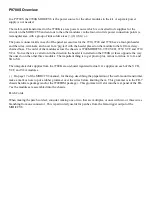
User Manual of Smart Digital Storage Oscilloscope
74
(3)
Press the
Acquire
button to display the Acquire menu.
(4)
Press the
H1
button to display the Acquire Mode
menu.
(5)
Press the
F2
button to choose
Peak detect
.
(6)
Press the
Trigger Menu
button to display the Trigger
menu.
(7)
Press the
H1
button to display the Trigger Type menu.
(8)
Press the
F1
to choose
Single
as the type.
(9)
Turn the
M
knob to choose
Edge
as the mode.
(10)
Press the
H2
button to display the
Source
menu.
(11)
Press the
F1
button to choose
CH1
as the source.
(12)
Press the
H3
button to display the Coupling menu; press the F2 button to choose
DC
as the Coupling.
(13)
Press the
H4
button to choose
(rising
)
as the Slope.
(14)
Rotate the
TRIG LEVEL
knob and adjust the trigger level to the mid-value of
the signal to be measured.
(15)
If the
Trigger State Indicator
at the top of the screen does not indicate
Ready
,
push down the
Run/Stop
button and start acquiring
,
waiting the emergence of the
signal in conformity with the trigger conditions. If a signal reaches to the set
trigger level, one sampling will be made and then displayed in the screen. With
this function, any random occurrence can be captured easily. Taking the burst
burr of larger amplitude for example, set the trigger level to the value just greater
than the normal signal level, and then presses the
Run/Stop
button and waits.
When there is a burr occurring, the instrument will trigger automatically and
record the waveform generated during the period around the trigger time. With
the
HORIZONTAL POSITION
knob in the horizontal control area in the panel
rotated, you can change the horizontal position of the trigger position to obtain
the negative delay, making an easy observation of the waveform before the burr
occurs (see
Fig.6-3
).















































